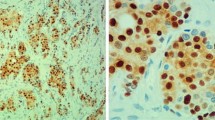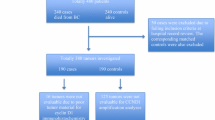Abstract
Introduction
Despite strong evidence regarding the role of CCND1 amplification and protein overexpression in breast carcinoma, the associations between CCND1 amplification/cyclin D1 overexpression and clinicopathological variables and clinical outcome remain controversial.
Aims of the study
(1) to correlate cyclin D1 expression with gene amplification; (2) to analyse the correlations between CCND1 amplification and overexpression with clinicopathological features and patients’ outcome in invasive breast cancer; (3) to define the prevalence and clinical significance of cyclin D1 overexpression and CCND1 amplification in ER positive breast carcinomas (4) to define the prevalence of cyclin D1 overexpression and CCND1 amplification in breast cancers with basal-like immunophenotype.
Materials and methods
CCND1 amplification and protein expression were assessed on a tissue microarray containing 880 unselected invasive breast cancer cases, by means of chromogenic in situ hybridisation using the Spotlight CCND1 amplification probe and immunohistochemistry, using the rabbit monoclonal antibody SP4.
Results
A total of 59/613 tumours (9.6%) showed CCND1 amplification and 224/514 (43.6%) showed strong cyclin D1 expression. A strong positive correlation between CCND1 amplification and higher levels of cyclin D1 expression was found (P < 0.001). Basal-like cancers showed infrequent CCND1 amplification and cyclin D1 overexpression (P < 0.001). Both CCND1 amplification and cyclin D1 expression were associated with positive ER status. CCND1 gene amplification was an independent prognostic factor for patients with ER positive breast cancer.
Conclusion
Our results demonstrate a strong correlation between CCND1 amplification and its protein expression in breast cancer. However, protein expression is more pervasive than gene amplification and associated with ER expression.


Similar content being viewed by others
References
Rakha EA, Green AR, Powe DG et al (2006) Chromosome 16 tumor-suppressor genes in breast cancer. Genes Chromosomes Cancer 45(6):527–535
Motokura T, Bloom T, Kim HG et al (1991) A novel cyclin encoded by a bcl1-linked candidate oncogene. Nature 350(6318):512–515
Oesterreich S, Deng W, Jiang S et al (2003) Estrogen-mediated down-regulation of E-cadherin in breast cancer cells. Cancer Res 63(17):5203–5208
Ma XJ, Salunga R, Tuggle JT et al (2003) Gene expression profiles of human breast cancer progression. Proc Natl Acad Sci USA 100:5974–5979
Wang TC, Cardiff RD, Zukerberg L et al (1994) Mammary hyperplasia and carcinoma in MMTV-cyclin D1 transgenic mice. Nature 369(6482):669–671
Zwijsen RM, Wientjens E, Klompmaker R et al (1997) CDK-independent activation of estrogen receptor by cyclin D1. Cell 88(3):405–415
Neuman E, Ladha MH, Lin N et al (1997) Cyclin D1 stimulation of estrogen receptor transcriptional activity independent of cdk4. Mol Cell Biol 17(9):5338–5347
Prall OW, Rogan EM, Musgrove EA et al (1998) c-Myc or cyclin D1 mimics estrogen effects on cyclin E-Cdk2 activation and cell cycle reentry. Mol Cell Biol 18(8):4499–4508
Altucci L, Addeo R, Cicatiello L et al (1996) 17beta-Estradiol induces cyclin D1 gene transcription, p36D1-p34cdk4 complex activation and p105Rb phosphorylation during mitogenic stimulation of G(1)-arrested human breast cancer cells. Oncogene 12(11):2315–2324
Musgrove EA, Lee CS, Buckley MF et al (1994) Cyclin D1 induction in breast cancer cells shortens G1 and is sufficient for cells arrested in G1 to complete the cell cycle. Proc Natl Acad Sci USA 91(17):8022–8026
Quelle DE, Ashmun RA, Shurtleff SA et al (1993) Overexpression of mouse D-type cyclins accelerates G1 phase in rodent fibroblasts. Genes Dev 7(8):1559–1571
Baldin V, Lukas J, Marcote MJ et al (1993) Cyclin D1 is a nuclear protein required for cell cycle progression in G1. Genes Dev 7(5):812–821
Musgrove EA, Hamilton JA, Lee CS et al (1993) Growth factor, steroid, and steroid antagonist regulation of cyclin gene expression associated with changes in T-47D human breast cancer cell cycle progression. Mol Cell Biol 13(6):3577–3587
Molland JG, Donnellan M, Janu NC et al (2004) Infiltrating lobular carcinoma—a comparison of diagnosis, management and outcome with infiltrating duct carcinoma. Breast 13(5):389–396
Zukerberg LR, Yang WI, Gadd M et al (1995) Cyclin D1 (PRAD1) protein expression in breast cancer: approximately one-third of infiltrating mammary carcinomas show overexpression of the cyclin D1 oncogene. Mod Pathol 8(5):560–567
Reis-Filho JS, Savage K, Lambros MB et al (2006) Cyclin D1 protein overexpression and CCND1 amplification in breast carcinomas: an immunohistochemical and chromogenic in situ hybridisation analysis. Mod Pathol 19(7):999–1009
Ormandy CJ, Musgrove EA, Hui R et al (2003) Cyclin D1, EMS1 and 11q13 amplification in breast cancer. Breast Cancer Res Treat 78(3):323–335
Mrhalova M, Kodet R, Strnad P (2002) Invasive ductal carcinoma of the breast: study of the number of copies of the CCND1 gene and chromosome 11 using fluorescence in situ hybridization (FISH) in comparison with expression of cyclin D1 protein and estrogen receptors (ER alpha) with immunohistochemical detection. Cas Lek Cesk 141(22):708–714
Jirstrom K, Stendahl M, Ryden L et al (2005) Adverse effect of adjuvant tamoxifen in premenopausal breast cancer with cyclin D1 gene amplification. Cancer Res 65(17):8009–8016
Chen X, Bargonetti J, Prives C (1995) p53, through p21 (WAF1/CIP1), induces cyclin D1 synthesis. Cancer Res 55(19):4257–4263
Reis-Filho JS, Simpson PT, Jones C et al (2005) Pleomorphic lobular carcinoma of the breast: role of comprehensive molecular pathology in characterization of an entity. J Pathol 207(1):1–13
Reis-Filho JS, Milanezi F, Carvalho S et al (2005) Metaplastic breast carcinomas exhibit EGFR, but not HER2, gene amplification and overexpression: immunohistochemical and chromogenic in situ hybridization analysis. Breast Cancer Res 7(6):R1028–R1035
Lambros MB, Simpson PT, Jones C et al (2006) Unlocking pathology archives for molecular genetic studies: a reliable method to generate probes for chromogenic and fluorescent in situ hybridization. Lab Invest 86(4):398–408
Elsheikh SE, Green AR, Lambros MBK, Turner NC, Grainge MJ, Powe D, Ellis IO, Reis-Filho JS (2007) FGFR1 amplification in breast carcinomas: a chromogenic in situ hybridisation analysis. Breast Cancer Res 9(2):R23
Madjd Z, Pinder SE, Paish C et al (2003) Loss of CD59 expression in breast tumours correlates with poor survival. J Pathol 200(5):633–639
Elston CW, Ellis IO (1991) Pathological prognostic factors in breast cancer. I. The value of histological grade in breast cancer: experience from a large study with long-term follow-up. Histopathology 19(5):403–410
Singletary SE, Connolly JL (2006) Breast cancer staging: working with the sixth edition of the AJCC cancer staging manual. CA Cancer J Clin 56(1):37–47
Galea MH, Blamey RW, Elston CE et al (1992) The Nottingham Prognostic Index in primary breast cancer. Breast Cancer Res Treat 22(3):207–219
Abd El-Rehim DM, Ball G, Pinder SE et al (2005) High-throughput protein expression analysis using tissue microarray technology of a large well-characterised series identifies biologically distinct classes of breast cancer confirming recent cDNA expression analyses. Int J Cancer 116(3):340–350
Abd El-Rehim DM, Pinder SE, Paish CE et al (2004) Expression and co-expression of the members of the epidermal growth factor receptor (EGFR) family in invasive breast carcinoma. Br J Cancer 91(8):1532–1542
Rakha EA, Putti TC, Abd El-Rehim DM et al (2006) Morphological and immunophenotypic analysis of breast carcinomas with basal and myoepithelial differentiation. J Pathol 208(4):495–506
Cheuk W, Chan JK (2004) Subcellular localization of immunohistochemical signals: knowledge of the ultrastructural or biologic features of the antigens helps predict the signal localization and proper interpretation of immunostains. Int J Surg Pathol 12(3):185–206
Harvey JM, Clark GM, Osborne CK et al (1999) Estrogen receptor status by immunohistochemistry is superior to the ligand-binding assay for predicting response to adjuvant endocrine therapy in breast cancer. J Clin Oncol 17(5):1474–1481
Abd El-Rehim DM, Ball G, Pinder SE et al (2005) High throughput protein expression analysis using tissue microarray technology of a large well characterised series identifies biologically distinct classes of breast cancer confirming recent cDNA expression analyses. Int J Cancer 116(3):340–350
Makretsov NA, Huntsman DG, Nielsen TO et al (2004) Hierarchical clustering analysis of tissue microarray immunostaining data identifies prognostically significant groups of breast carcinoma. Clin Cancer Res 10(18 Pt 1):6143–6151
Barnes DM, Gillett CE (1998) Cyclin D1 in breast cancer. Breast Cancer Res Treat 52(1–3):1–15
Butt AJ, McNeil CM, Musgrove EA et al (2005) Downstream targets of growth factor and oestrogen signalling and endocrine resistance: the potential roles of c-Myc, cyclin D1 and cyclin E. Endocr Relat Cancer 12(Suppl 1):S47–S59
Buckley MF, Sweeney KJ, Hamilton JA et al (1993) Expression and amplification of cyclin genes in human breast cancer. Oncogene 8(8):2127–2133
Barbareschi M, Pelosio P, Caffo O et al (1997) Cyclin-D1-gene amplification and expression in breast carcinoma: relation with clinicopathologic characteristics and with retinoblastoma gene product, p53 and p21WAF1 immunohistochemical expression. Int J Cancer 74(2):171–174
Cheuk W, Wong KO, Wong CS et al (2004) Consistent immunostaining for cyclin D1 can be achieved on a routine basis using a newly available rabbit monoclonal antibody. Am J Surg Pathol 28(6):801–807
Watts CK, Sweeney KJ, Warlters A et al (1994) Antiestrogen regulation of cell cycle progression and cyclin D1 gene expression in MCF-7 human breast cancer cells. Breast Cancer Res Treat 31(1):95–105
Michalides R, Hageman P, van Tinteren H et al (1996) A clinicopathological study on overexpression of cyclin D1 and of p53 in a series of 248 patients with operable breast cancer. Br J Cancer 73(6):728–734
Caldon CE, Daly RJ, Sutherland RL et al (2006) Cell cycle control in breast cancer cells. J Cell Biochem 97(2):261–274
Olsson H, Borg A, Ferno M et al (1991) Her-2/neu and INT2 proto-oncogene amplification in malignant breast tumors in relation to reproductive factors and exposure to exogenous hormones. J Natl Cancer Inst 83(20):1483–1487
Hui R, Ball JR, Macmillan RD et al (1998) EMS1 gene expression in primary breast cancer: relationship to cyclin D1 and oestrogen receptor expression and patient survival. Oncogene 17(8):1053–1059
Vaziri SA, Tubbs RR, Darlington G et al (2001) Absence of CCND1 gene amplification in breast tumours of BRCA1 mutation carriers. Mol Pathol 54(4):259–263
Koziczak M, Holbro T, Hynes NE (2004) Blocking of FGFR signaling inhibits breast cancer cell proliferation through downregulation of D-type cyclins. Oncogene 23(20):3501–3508
Cicatiello L, Addeo R, Sasso A et al (2004) Estrogens and progesterone promote persistent CCND1 gene activation during G1 by inducing transcriptional depression via c-Jun/c-Fos/estrogen receptor (progesterone receptor) complex assembly to a distal regulatory element and recruitment of cyclin D1 to its own gene promoter. Mol Cell Biol 24(16):7260–7274
Loden M, Stighall M, Nielsen NH et al (2002) The cyclin D1 high and cyclin E high subgroups of breast cancer: separate pathways in tumorogenesis based on pattern of genetic aberrations and inactivation of the pRb node. Oncogene 21(30):4680–4690
Korsching E, Packeisen J, Agelopoulos K et al (2002) Cytogenetic alterations and cytokeratin expression patterns in breast cancer: integrating a new model of breast differentiation into cytogenetic pathways of breast carcinogenesis. Lab Invest 82(11):1525–1533
Cuny M, Kramar A, Courjal F et al (2000) Relating genotype and phenotype in breast cancer: an analysis of the prognostic significance of amplification at eight different genes or loci and of p53 mutations. Cancer Res 60(4):1077–1083
Courjal F, Louason G, Speiser P et al (1996) Cyclin gene amplification and overexpression in breast and ovarian cancers: evidence for the selection of cyclin D1 in breast and cyclin E in ovarian tumors. Int J Cancer 69(4):247–253
Seshadri R, Lee CS, Hui R et al (1996) Cyclin DI amplification is not associated with reduced overall survival in primary breast cancer but may predict early relapse in patients with features of good prognosis. Clin Cancer Res 2(7):1177–1184
Bieche I, Olivi M, Nogues C et al (2002) Prognostic value of CCND1 gene status in sporadic breast tumours, as determined by real-time quantitative PCR assays. Br J Cancer 86(4):580–586
Kenny FS, Willsher PC, Gee JM et al (2001) Change in expression of ER, bcl-2 and MIB1 on primary tamoxifen and relation to response in ER positive breast cancer. Breast Cancer Res Treat 65(2):135–144
Acknowledgements
This study was in part funded by the Breast Cancer Campaign and Breakthrough Breast Cancer. SE and MA are funded by the Egyptian culture bureau.
Author information
Authors and Affiliations
Corresponding authors
Electronic supplementary material
Below is the link to the electronic supplementary material.
Rights and permissions
About this article
Cite this article
Elsheikh, S., Green, A.R., Aleskandarany, M.A. et al. CCND1 amplification and cyclin D1 expression in breast cancer and their relation with proteomic subgroups and patient outcome. Breast Cancer Res Treat 109, 325–335 (2008). https://doi.org/10.1007/s10549-007-9659-8
Received:
Accepted:
Published:
Issue Date:
DOI: https://doi.org/10.1007/s10549-007-9659-8




